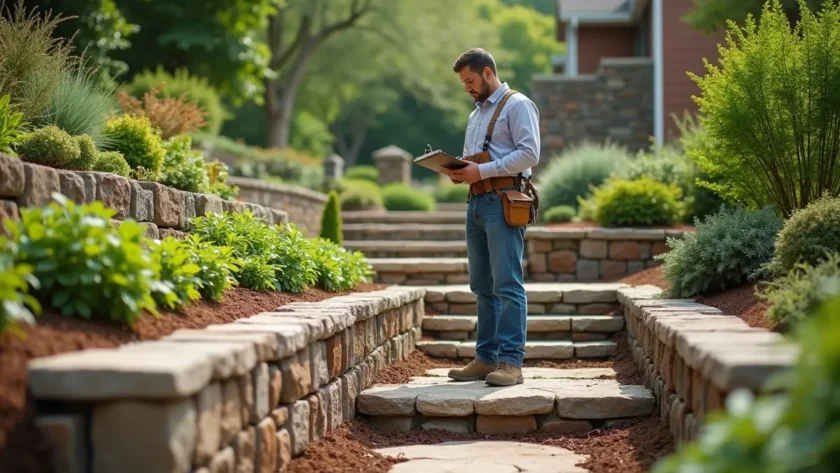Sloped yards can be both a blessing and a challenge for homeowners looking to maximize their outdoor space. The natural incline can create stunning visual interest, but it also introduces unique issues like controlling water runoff, preventing soil erosion, and maintaining accessibility. Fortunately, with careful planning and a few strategic landscaping choices, it’s possible to transform even the steepest lawn into a functional and attractive retreat. From terraced garden solutions to proper slope stabilization techniques, there are many ways to tap into the hidden potential of an inclined property.
Contents
Planning Sloped Yard Design Ideas
A well-thought-out plan is the foundation for successful projects involving landscaping sloped yards. Begin by carefully examining the extent of your slope, noting any potential drainage problems or vulnerable spots prone to erosion. If the incline is especially steep, you may need to consider professional grading techniques to ensure adequate slope stability. Gentle slopes often allow more creative flexibility, so minor adjustments might be enough to keep water moving away from your home.
Think about using tiers to make the most of your available space. Terraced landscaping can be achieved by installing small retaining edges between levels. Each tier can then serve a different purpose, whether it’s a flower bed, a seating area, or a pathway. This method breaks up the expanse of a hill while adding visual rhythm to your sloped yard. You’ll also get distinct sections where you can experiment with sloped lawn care or introduce new plants.
Varied hardscaping is another avenue to explore. By integrating stones, steps, or wooden pathways, you can create a more defined look and easier navigation. Hardscape options for sloped areas may also include steps made of pavers, which connect separate levels while blending into the landscape. The key is to consider long-term functionality: choose durable materials and designs that won’t deteriorate under changing weather conditions.
Drainage Solutions for Sloped Yards
Managing water runoff is crucial for any sloping property. When left unchecked, rainwater can cause damage to foundations, wash away topsoil, or create muddy puddles at the base of the slope. Drainage solutions for sloped yards often start with simple measures like gravel trenches or French drains. These low-profile systems divert water efficiently, especially around patios or pathways that might otherwise get flooded. Although the concept is simple, the effectiveness of a French drain can depend entirely on correct placement, trench depth, and proper material layering. For this reason, homeowners can tackle serious or complex slope drainage issues with the help of professional french drain installation services to ensure that the system is correctly graded and sized to handle the expected water volume, providing a reliable long term solution.
Installing a rain garden is another appealing way to help with water runoff management for slopes. A rain garden is a shallow, planted depression designed to capture and filter rainwater, reducing the risk of pooling and soil saturation. By selecting water-tolerant plants and incorporating a layer of gravel, you can guide overflow away from your main living spaces. This approach offers a natural and decorative alternative to standard pipe-and-grate solutions.
Controlling Excess Runoff
Sometimes, a more robust setup is needed for a severely sloped backyard landscaping plan. In those cases, consider contouring the slope to slow down the flow of water before it reaches storm drains. Small terraces or strategically placed stones can break up the path of rainfall, preventing soil erosion. It’s also wise to look into slope irrigation systems that carefully regulate water usage, ensuring your plants get enough moisture without contributing to excessive runoff.
Retaining Walls for Slopes and Soil Stability
Retaining walls are a common way to address both functionality and aesthetic appeal on an incline. They help prevent erosion control for sloped yards by holding back soil while creating flat, usable ground on each level. Popular materials include concrete blocks, stone, and treated wood. Each option can be customized to match your home’s style. Retaining walls that echo elements of the house’s façade often tie your outdoor space together.
When elaborate slope stabilization techniques become necessary, multi-tiered or stepped retaining walls can be designed with integrated planting beds. This arrangement lends a layered look and encourages strategic planting on a slope. Consider placing small shrubs or groundcovers near the upper levels so that their roots help shore up the soil. In the lower levels, ornamental grasses or decorative flowers can soften the solid lines of the retaining wall.
Enhancing Visual Appeal
If you’d like to create a bold statement while preventing soil movement, try introducing curved retaining walls that trace the natural contours of your yard. This approach amplifies your property’s organic shape while ensuring slope stability. You could accent the wall with creeping plants, which will cascade gently over the edges, adding color and life to the construction. Even though retaining walls serve a structural purpose, they need not appear purely utilitarian.
Planting on a Slope and Erosion Control
Lush vegetation can be one of the most effective strategies for erosion prevention. The roots of many plants hold the soil in place and help regulate water flow. For instance, low-growing groundcovers like juniper or creeping phlox provide year-round coverage while also smothering weeds. Wildflowers and ornamental grasses can transform a hilly yard landscaping project into a vibrant habitat that appeals to birds and pollinators.
Choosing popular plants for sloped yards involves researching root depth and water needs. Selecting native species that tolerate local climate extremes helps reduce the effort required for sloped yard maintenance. By blending shrubs, perennials, and groundcovers, you create a multilayered network of roots that better stabilizes soil. Elevated flower beds or pockets of shrubs also offer visual diversity and break up the slope into smaller sections.
Techniques for Plant Installation
When you’re ready for planting on a slope, dig horizontal trenches for seedlings and small shrubs instead of simply planting them in vertical holes. These mini terraces help catch water and direct it toward the plant’s roots. You may also need to add a layer of mulch or organic matter on top to retain moisture and prevent rapid runoff. Try slope soil management methods like using biodegradable netting or jute matting to hold the mulch in place until your plants become established.
For larger slopes, consider integrating slope erosion control fabrics beneath your topsoil. This measure adds an extra barrier against washing and helps newly planted root systems take hold. Over time, the fabric biodegrades, leaving you with a stable and naturally integrated landscape. It’s a way to combine short-term stability enhancements with long-term ecological health.
Sloped Yard Maintenance and Accessibility
Maintaining a sloped yard relies on good planning and a willingness to adapt your methods over time. Regularly check the condition of your retaining walls and drainage solutions to ensure water continues to flow away from your home. Keep an eye on plant health, as weak or dying vegetation can leave the soil more prone to erosion. If you see any signs of slope damage, address them quickly to prevent further deterioration.
Another element to consider is how to make the yard accessible for all family members. Gentle pathways that zigzag across the slope can offer a safe walking surface, reducing the severity of the incline. When adding steps or ramps, consult local codes to ensure correct handrail heights and non-slip surfaces. Accessibility in sloped yards often includes a mix of switches, landings, and terraced steps. Each of these elements can match your overall garden design for sloped yards if you blend them with the materials and plants you’ve already introduced.
Creative Uses for Sloped Land
If traditional gardens and seating areas don’t excite you, think about creative uses for sloped land. Some homeowners build multi-level decks that follow the slope’s natural contours. Others add water features like small cascading streams that flow downhill, offering both a visual and auditory highlight. Even an outdoor slide or play area can find a perfect spot on a gentle incline, making use of extra vertical space. By combining slope irrigation with thoughtful layout choices, you can ensure your yard remains green and inviting no matter the angle.
Embracing the challenges of an uneven yard can reveal new opportunities for imaginative design. It might seem daunting at first, but each successful step paves the way for a personal oasis that works with, rather than against, the natural terrain. Whether you choose garden terraces, retaining walls, or slope erosion control fabrics, all elements can converge to create a space that feels cohesive and welcoming. With consistent upkeep and an eye for detail, your sloped yard can become a rewarding part of your home’s landscape, ensuring beauty and functionality for many seasons to come.




